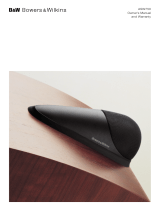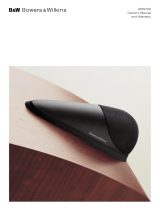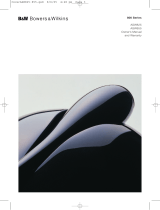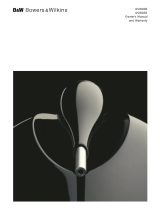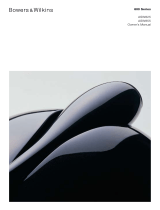Page is loading ...

Owner’s Manual
ASW
™
2500

Figure 1
Figure 2
Figure 3
ASW
™
2500 Owner’s manual
English ...............................1
Français..............................4
Deutsch ..............................8
Español ............................11
Português ..........................15
Italiano.............................18
Nederlands .......................21
Dansk...............................24
Ελληνικ .........................26
Русский...........................30
Svenska............................34
Norsk...............................34
Suomi...............................34

1
IMPORTANT
SAFETY
INSTRUCTIONS
Caution:
To reduce the risk of electric shock, do not
remove the back panel. No user-serviceable
parts inside. Refer servicing to qualified
personnel.
Explanation of Graphical Symbols:
The lightning flash within an
equilateral triangle is intended to
alert you to the presence of
uninsulated “dangerous voltage”
within the product’s enclosure that
may be of sufficient magnitude to
constitute an electric shock to
persons.
The exclamation point within an
equilateral triangle is intended to
alert you to the presence of
important operating and
maintenance (servicing) instructions
in the literature accompanying the
appliance.
1 Read Instructions – All the safety and
operating instructions should be read before
the appliance is operated.
2 Retain Instructions – The safety and operating
instructions should be retained for future
reference.
3 Heed Warnings – All warnings on the
appliance and in the operating instructions
should be adhered to.
4 Follow Instructions – All operating and use
instructions should be followed.
5 Cleaning – Unplug the product from the wall
outlet before cleaning. Refer to the cleaning
instructions in the section of the manual titled
“Aftercare”.
6 Attachments – Do not use attachments not
recommended by the product manufacturer,
as they may cause hazards.
7 Water and Moisture – Do not use this
product near water – for example, near a
bathtub, washbowl, kitchen sink, laundry tub,
in a wet basement, or near a swimming pool
and the like.
8 Accessories – Do not place this product on
an unstable cart, stand, tripod, bracket or
table. The product may fall, causing serious
injury to a child or adult, and serious
damage to the product. Use only with a cart,
stand, tripod, bracket or table recommended
by the manufacturer or sold with the product.
Any mounting of the product should follow
the manufacturerís instructions and should use
a mounting accessory recommended by the
manufacturer.
9 A product and cart combination should be
moved with care. Quick stops, excessive
force and uneven surfaces may cause the
product and cart combination to overturn.
10 Ventilation – Openings in the rear control
panel are provided for ventilation and to
ensure reliable operation of the product and
to prevent it from overheating, and these
openings must not be blocked or covered.
The panel itself forms part of the cooling
mechanism and must not be obscured by
placing the product on a bed, sofa, rug, or
other similar surface. The product should not
be placed in a built-in installation, such as a
rack, bookcase or cabinet unless proper
ventilation is provided or the manufacturer’s
instructions have been adhered to.
11 Power Sources – This product should be
operated only from the type of power source
indicated on the marking label situated on
the rear panel above the power input socket.
If you are not sure of the type of power
supply to your home, consult your product
dealer or local power company.
12 Grounding or Polarisation – The appliance is
not required to be grounded. Versions of the
product marked for use with 120V power
supplies are equipped with a power cord
fitted with a polarised alternating line plug (a
plug having one blade wider than the other).
This plug will fit onto the power outlet only
one way. This is a safety feature. If you are
unable to insert the plug fully into the outlet,
try reversing the plug. If the plug should still
fail to fit, contact your electrician to replace
your obsolete outlet. Do not defeat the safety
purpose of the polarised plug. When using
an extension power-supply cord or a power-
supply cord other than that supplied with the
appliance, it should be fitted with the
appropriate moulded-on plugs and carry
safety approval appropriate to the country of
use.
12 Power Cord Protection – Power-supply cords
should be routed so that they are not likely to
be walked on or pinched by items placed on
or against them, paying particular attention
to cords at plugs, convenience receptacles
and the point where they exit from the
appliance.
13 Overloading – Do not overload wall outlets,
extension cords or integral convenience
receptacles, as this can result in a risk of fire
or electric shock.
14 Non-use Periods – The power cord of the
appliance should be unplugged from the
outlet when left unused for a long period of
time.
15 Object and Liquid Entry – Never push
objects of any kind into this product through
openings, as they may touch dangerous
voltage points or short out parts that could
result in a fire or electric shock. Never spill
liquid of any kind on the product.
16 Servicing – Do not attempt to service this
product yourself, as opening or removing
covers may expose you to dangerous voltage
or other hazards. Refer all servicing to
qualified service personnel.
17 Damage Requiring Service – Unplug this
product from the wall outlet and refer
servicing to qualified personnel under the
following conditions:
a When the power-supply cord or plug has
been damaged.
b If liquid has been spilled or objects have
fallen into the appliance.
c If the product has been exposed to rain or
water.
d If the product does not operate normally
by following the operating instructions.
Adjust only those controls that are covered
by the operating instructions, as an
improper adjustment of other controls
may result in damage and will often
require extensive work by a qualified
technician to restore the product to its
normal operation.
e If the product has been dropped, or
damaged in any way.
f When the product exhibits a distinct
change in performance – this indicates a
need for service.
18 Replacement Parts – When replacement parts
are required, be sure the service technician
has used replacement parts specified by the
manufacturer or have the same characteristics
as the original part. Unauthorised
substitutions may result in fire, electric shock
or other hazards.
19 Safety Check – Upon completion of any
service or repairs to this product, ask the
service technician to perform safety checks to
determine that the product is in proper
operating condition.
20 Wall or Ceiling Mounting – The product
should be mounted to a wall or ceiling only
as recommended by the manufacturer.
21 Heat – The product should be situated away
from heat sources such as radiators, heat
registers, stoves, or other products (including
amplifiers) that produce heat.

2
WARNINGS:
CAUTION: 120V versions of the product are
supplied with a power cord equipped with a
polarised plug. To prevent electric shock, match
wide blade of plug to wide slot, fully insert.
Ensure the plug is fully inserted into the wall
outlet or extension cord receptacle to prevent
blade or pin exposure.
To prevent fire or shock hazard, do not expose
this equipment to rain or moisture.
Observe all warnings on the equipment itself.
To avoid electrical shock, do not open the
enclosure or remove the amplifier from the rear
panel. There are no user serviceable parts
inside. Refer all service questions to an
authorised B&W dealer.
Ensure that the voltage indicated on the amplifier
panel matches that of the power supply.
The mains fuse holder is located on the back
panel of the amplifier module. Replacement fuse
must be of the same type and rating as supplied
and marked on the product.
The product does not require earthing
(grounding).
Ensure the product is adequately ventilated. Do
not prevent air from circulating round the rear
amplifier panel. Do not obscure or block the
openings in the panel. Do not use the product in
a rack, bookcase, cabinet or cupboard unless
the volume behind the product is adequately
ventilated to the room space.
Check that there are no cables under the carpet
that may be damaged by the spike feet.
Do not walk the product on the spike feet as this
may cause them to become detached from the
cabinet and cause damage.
Take care not to impale yourself with the spike
feet when moving the product.
Introduction
Thank you for purchasing the B&W ASW™2500
Active Subwoofer.
Since its foundation in 1966, the continuing
philosophy of B&W has been the quest for
perfect sound reproduction. Inspired by the
company’s founder, the late John Bowers, this
quest has entailed not only high investment in
audio technology and innovation but also an
abiding appreciation of music and the demands
of film sound to ensure that the technology is put
to maximum effect.
The ASW™2500 has been designed for Home
Theatre installations and to augment the bass
performance of full-range speakers in 2-channel
audio use. Adding the subwoofer to your system
not only extends the bass to lower frequencies, it
improves the midrange clarity by reducing the
low-frequency demands on your existing
speakers.
Please read through this manual fully before
using the subwoofer. All sound installations
require some planning and experimentation if
you are to get the best out of the products used
and this manual will guide you in this process.
As the subwoofer is connected to the electricity
power supply, it is important that you familiarise
yourself with the safety instructions and heed all
warnings.
Keep this manual in a safe place for future
reference.
B&W loudspeakers are distributed to over 60
countries worldwide and we maintain an
international network of carefully chosen and
dedicated distributors. If you have a problem,
which your dealer cannot resolve, our distributors
will be more than willing to assist you.
Unpacking
(figure 1)
The easiest way to unpack the subwoofer and
avoid damage is as follows:
• Open the carton flaps right back and invert
the carton and contents.
• Lift the carton away from the product.
We recommend that you retain the packaging
for future use.
In addition to this manual, the carton should
contain:
1 Subwoofer
1 Accessory pack containing:
4 Rubber feet
4 Spike feet
4 Lock nuts
1 International warranty document
A tour of the subwoofer
(figure 2)
1 LINK OUT sockets
2 LINE OUT sockets
3 LINE IN sockets
4 VOLUME control
5 LOW-PASS FREQUENCY control
6 PHASE switch
7 LOW-PASS FILTER defeat switch
8 EQualisation switch
9 POWER On/Auto/Standby switch
10 Power/Standby indicator
11 Ventilation holes
12 Power input socket
13 Power isolator switch (230V versions only)
14 Fuse holder
Positioning the subwoofer
Because the subwoofer produces only low-
frequency sounds, positioning is less critical in
some respects compared to full-range speakers.
Directional information is much less precise and
you have more choice where to place the
speakers to good effect. This said, best results
are obtained if the subwoofer is placed between
the satellite speakers or in the vicinity of one of
them. If you use two subwoofers, it is best to put
one near each satellite speaker.
Placing the subwoofer behind the listeners, even
in surround sound installations, generally gives
inferior imaging, but may be an acceptable
compromise if domestic considerations dictate.
As with all speakers, the proximity of room
boundaries affects the sound. Bass is generally
increased as more surfaces come into close
proximity with the speakers. Unlike full-range
speakers, however, you can always restore the
correct overall system balance by adjusting the
volume level of the subwoofer. The more boost
you get from the room, the less hard the speaker
has to work; but there is a down side. Corner
positions often excite more low-frequency room
resonances, making the bass more uneven with
frequency. There is no substitute for experiment
as all rooms behave differently, so try the
subwoofer in a variety of positions before
making a final decision. A piece of music with a
bass line ascending or descending the musical
scale is useful for assessing the smoothness of
the bass response. Listen for exaggerated or
quiet notes. Having a separate subwoofer does
enable you to optimise for room resonances
independently from siting the satellite speakers
for best imaging.
If the subwoofer is to be used in a confined
space (eg in custom furniture), the space must be
ventilated to allow sufficient air to circulate and
cool the unit. Ask your dealer for advice.
The subwoofer is supplied with four spike feet.
The spikes pierce through carpet pile, giving a
firm support directly to the floor surface without
crushing the pile.
If the unit is to be placed on a vulnerable
surface, such as a wooden floor, either place a
protective disc under each spike or fit the four
rubber feet in place of the spikes.
When fitting either the rubber feet or the spike
feet, first screw the lock nuts fully onto the thread
and then screw the feet fully onto the threaded
inserts in the base of the cabinet. If the unit
rocks, loosen the relevant two opposing feet until
the support is firm, then re-tighten the lock nuts to
the inserts.
Electrical connections
Disconnect all sound system equipment from the
power supply until the signal connections have
been made and checked. This avoids the risk of
damage whilst connections are made or broken.
The function of the subwoofer is to receive
signals from the amplification chain and, where

3
necessary for 2-channel audio, split the signal
into low bass and higher frequencies and feed
the latter back out to the satellite speakers. Left
and right channel inputs may be combined into
a single mono low bass feed to the subwoofer
drive unit if required.
The subwoofer will input and output line-level
signals via the RCA Phono sockets located on
the back panel.
Use the following table to select the correct
wiring method for your installation:
Application: Home Theatre
The subwoofer may be used with any decoder
that has a line-level subwoofer output (normally
from an RCA Phono socket). Most decoders with
integral power amplifiers still output the
subwoofer or Low-Frequency Effects (LFE) signal
at line level.
• Decoder with one or more subwoofers –
fig. 3
Application: 2-channel audio
Separate pre- & power amplifiers:
a One or more subwoofers with output
combined into a single mono signal – fig. 4
b Two subwoofers with separate left and right
signal – fig. 5
The ASW™2500 is not suitable for use with 2-
channel integrated pre/power amplifiers, unless
they feature a line level output from the pre-
amplifier.
Using more than one subwoofer
Using more than one unit in a single installation
can improve performance in the following ways:
• Maintain stereo separation to the lowest
frequencies.
• Cope with larger listening rooms.
• Enable greater maximum sound output –
often useful for effectively reproducing
special effects in Home Theatre applications.
• Smooth out the effects of low-frequency room
resonances.
If you are using two subwoofers for 2-channel
audio, separation is improved if each channel
has its own subwoofer, providing each one is
placed close to the relevant satellite speaker.
Only use the mono connection of figure 4 if you
cannot place each subwoofer close to its satellite
speaker.
Double-check the connections
ENSURE THAT THE VOLTAGE INDICATED ON
THE AMPLIFIER PANEL MATCHES THAT OF THE
POWER SUPPLY.
Before auditioning the sound quality of your new
installation and fine-tuning it, double-check the
connections. All too often, users complain that
they cannot get a decent sound however they set
the controls, only to discover something has been
wrongly connected. Make sure that:
• The phasing is correct – there should be no
positive to negative connections to the
satellite speakers. If something is out of
phase you may get a fuzzy sound with an
imprecise and floating image, a lack of bass
or a combination of the two.
• There are no left to right mix-ups – this can
result, for example, in the orchestra being the
wrong way round or, more disastrously,
sounds on your Home Theatre going in the
opposite direction to the action on the
screen.
Switching on and off
We recommend that you switch the subwoofer
on before any power amplifiers receiving signals
from the subwoofer. Similarly, when switching
off, switch the subwoofer off last.
The on/auto/standby switch (9) at the top right
of the amplifier panel does not isolate the
amplifier completely from the power supply. It
maintains a low-power input to an auxiliary
sensing circuit. The 230V version of the amplifier
has an additional switch (13) that completely
isolates the power supply. To isolate other
versions, either switch off at the wall outlet or
disconnect the power cord from the amplifier.
We recommend you isolate the subwoofer from
the power supply if it is to be out of use for
extended periods of time.
The switch (9) operates as follows:
On:
With the switch in this position, the amplifier
remains permanently on, and the light glows
green.
Auto:
On first switching the subwoofer to Auto, the
amplifier becomes fully active and the light (10)
above the on/auto/standby switch glows green.
After a period of about 5 minutes without an
input signal, the amplifier automatically reverts to
standby mode, and the light glows red. When
an input signal is detected, the amplifier
automatically becomes fully active and the light
glows green.
Standby:
In this position, the amplifier is in permanent
standby, and the light glows red.
Setting the controls
There are 5 controls to consider:
• The VOLUME control (4)
• The LOW-PASS FREQUENCY control (5)
• The PHASE switch (6)
• The LOW-PASS FILTER switch (7)
• The EQ (equalisation) switch (8)
The optimum settings depend on the other
equipment used with the subwoofer. If using
more than one subwoofer, ensure the controls on
each one are set the same.
Use with home theatre decoders
The ASW™2500 is not a THX
®
licensed
component, but may be used with a THX
®
controller if desired.
• Set the decoder VOLUME control to the half
way (12 o’clock) position.
• The setting of the LOW-PASS FREQUENCY
control is irrelevant.
• Set the PHASE switch initially to 0˚.
• Set the LOW-PASS FILTER switch to OUT.
• Set the EQ switch initially to position A.
See also the section “Fine tuning”.
If you have a THX
®
controller, ensure that the
subwoofer function is enabled. When so
configured it incorporates all the filtering and
level setting required for the subwoofer in all
modes. For level calibration, the internal test
noise and channel level controls in the THX
®
controller should be used. In all cases the levels
should be set to obtain 75dB SPL (C-weighted)
at the listening position from the controller’s
internal noise test signal.
With other decoders, configure the front and
surround speakers to “large” or “small” as
appropriate before setting the levels. Use the
internal noise test signal and volume controls of
the decoder to set the levels of all the speakers.
Only change the VOLUME control on the
subwoofer if there is not enough range in the
decoder to achieve the correct levels.
Inexpensive sound level meters are readily
available from electronics stores and should be
used to calibrate the levels. Refer to your
decoder manual for further details on how to set
the levels.
Use for 2-channel audio
• Set the VOLUME control initially to the half
way (12 o’clock) position.
• Set the LOW-PASS FREQUENCY initially to
80Hz.
• Set the LOW-PASS FILTER switch to IN.
• Set the EQ switch initially to position B.
• Set the PHASE switch initially to 0˚.
See also the section “Fine tuning”.
Fine-tuning
There are two settings of the EQ switch. Position
A is optimised to allow the subwoofer to provide
the highest listening levels, while position B gives
greater bass extension coupled with a tighter
sound.
2-channel audio
The optimum settings of the PHASE switch and
the LOW-PASS FREQUENCY control are inter-
related and also dependent on the low-frequency
cut-off characteristic of the satellite speakers and

4
the relative positions of all the speakers in the
installation.
Set the system up in the preferred position and
play some programme with a steady bass
content. The optimum setting for the LOW-PASS
FREQUENCY depends on several variables; the
bass performance and power handling of the
satellite speakers, the number of subwoofers
used and their position relative to the satellite
speakers. The range 80 – 90Hz is a good
starting point for the LOW-PASS frequency.
Unless two subwoofers are used to preserve
separate right and left channel information and
are sited close to the relevant satellite speakers,
using a higher cut-off frequency may compromise
the stereo image and should only be considered
if the bass performance of the satellite speakers
is particularly limited.
At each setting of the cut-off frequency, listen
with the phase switch in both positions. The
correct one is that which gives the fullest bass
and that will depend on the bass characteristics
of your satellite speakers and the relative
distances of the subwoofer(s) and the satellite
speakers to the listeners. When using more than
one subwoofer, ensure that each one has its cut-
off frequency and phase switch set the same
way.
Set the loudness of the subwoofer relative to the
satellite systems to your liking. Use a wide
variety of programme material to get an average
setting. One that sounds impressive on one piece
may sound overpowering on another. Listen at
realistic levels as the perception of balance
varies with sound level.
Home theatre
The situation with home theatre is somewhat
different from 2-channel audio. The subwoofer
(LFE) signal is a separate channel rather than an
extension of the signal to the satellite speakers.
The LOW-PASS filter is switched out, because the
decoder provides all the filtering for any
speakers set to “small”. However, the position of
the phase switch must still be assessed. Normally
the phase will be set to 0˚, but if the subwoofer
is positioned at a distance significantly different
from the other speakers, or the power amplifier
driving the other speakers happens to invert the
signal, the 180˚ position may be preferable.
Listen with the switch in both positions and
choose the one that gives the fullest sound. If
there is little difference, leave the switch at 0˚.
Decoders normally have a calibrated noise
signal that can be used to set the relative levels
of all the speakers, making the task somewhat
more straightforward than for 2-channel audio.
However, do not be afraid to alter the settings to
your personal preference. It is all too easy to get
carried away with the capabilities of the
subwoofer, especially with some special low-
frequency effects. Often a more realistic
portrayal, and one more satisfying in the long
term, is to be had by setting the subwoofer level
lower that the standard calibration level.
All applications
If you get problems with lumpy bass – if certain
bass notes are exaggerated more than others –
then you probably have a room interface
problem and it is worth experimenting with the
placement of the subwoofer. What may seem
like small changes in position – 15cm (6in) or so
– can have a profound effect on the sound. Try
raising the subwoofer clear of the floor as well
as lateral movement. The use of multiple
subwoofers can smooth the effects of room
resonances, as each subwoofer will tend to
excite resonances at different frequencies. If you
alter the relative distances from the subwoofer(s)
and satellite speakers to the listeners
appreciably, reassess the phase switch setting.
You should also check the level setting of the
subwoofer (using either the decoder output levels
or the volume control on the subwoofer amplifier
as appropriate), but only after setting the phase
correctly.
Taking care of the subwoofer
The cabinet of the subwoofer may be cleaned
by dusting with a dry cloth. If you wish to use an
aerosol cleaning spray, do not spray directly on
the cabinet; spray onto the cloth. Remove the
grille first so that the cloth does not become
stained, but be careful not to disturb the drive
unit. The grille itself may be cleaned using a soft
brush.
Do not use the subwoofer as a table. When in
use, objects left on top of the subwoofer are
liable to rattle. In particular, avoid the risk of
liquids being spilled (eg from drinks or vases of
flowers).
If the system is taken out of use for a long
period, disconnect the subwoofer from the power
supply.
FRANÇAIS
AVERTISSEMENTS:
ATTENTION: les versions 120V de ce produit
sont livrées avec un cordon d’alimentation avec
connecteur polarisé. Pour éviter les chocs
électriques, introduisez la lame la plus large de
la fiche dans la borne correspondante de la
prise et poussez jusqu’au fond.
Pour éviter tout risque d’incendie ou
d’électrocution, n’exposez jamais cet appareil à
la pluie ou même a l’humidité.
Observez tout signe anormal pouvant provenir
du subwoofer lui-même.
N’ouvrez jamais l’enceinte et ne sortez pas
l’amplificateur de son logement ; vous n’y
trouverez aucun réglage utile. En cas de
problème renseignez-vous, préalablement à toute
intervention, auprès d’un véritable revendeur
spécialiste de la marque B&W.
Assurez-vous, en premier lieu, que la tension
indiquée sur l’appareil correspond bien a celle
de votre réseau électrique.
Les fusibles d’alimentation se trouvent sur le
panneau du module d’amplification. En cas
de remplacement, n’utilisez jamais de fusibles
d’un type différent ; vérifiez que les valeurs
indiquées sur les nouveaux fusibles sont
parfaitement identiques à celles qui figurent sur
les modèles d’origine.
Cet appareil ne doit pas être raccordé à
la terre.
Assurez-vous que l’appareil est correctement
aéré. N’empêchez-pas l’air de circuler autour de
la plaque d’amplification située à l’arrière.
N’obstruez-pas les ouvertures du panneau.
N’encastrez-pas cette enceinte dans un rack, une
étagère, une niche ou un meuble si le volume
disponible à l’arrière ne peut être ventilé par l’air
ambiant.
Contrôlez que les câbles ne risquent pas d’être
transpercés par les pointes de découplage.
Ne déplacez pas l’appareil en le faisant glisser
sur ses pointes. Vous risquez de les arracher ou
de créer des dégats.
Prenez simplement garde de ne pas vous piquer.
Introduction
Nous vous remercions d’avoir choisi l’enceinte
active de subgrave B&W ASW™2500.
Depuis la création de notre entreprise en 1966,
la base invariable de notre philosophie a toujours
été la recherche de la perfection absolue.
Inspirée par son fondateur, le regretté John
Bowers, cette extraordinaire aventure qu’est la
quête de l’absolu, n’a pas seulement débouché
sur de très lourds investissements consacrés à la
recherche et à l’innovation, mais aussi sur une
profonde connaissance de la musique et des
spécificités du son cinématographique. Cette

36
Description
Drive units
System frequency range
System frequency response
Amplifier
Internal Volume
Dimensions
Net Weight
ASW
™
2500
THX is a registered trademark of Lucasfilm Ltd.
B&W Loudspeakers Ltd. reserves the right to amend details of the specification without notice in line with technical developments.
Copyright © B&W Loudspeakers Ltd. Printed in England.
Manufactured by B&W Loudspeakers Ltd, Meadow Road, Worthing, BN11 2RX
Tel: +44 (0) 1903 524801 Fax: +44 (0) 1903 524725 http://www.bwspeakers.com
Service/Distribution:
B&W (UK) Ltd, Marlborough Road, Lancing, West Sussex, BN15 8TR, England. Tel: 01903 750750 Fax: 01903 750694
B&W Loudspeakers of America, 54 Concord Street, North Reading, M.A. 01864-2699 United States of America
Tel: (978) 664-2870 Fax: (978) 664-4109
B&W Loudspeakers (Asia) Ltd, Flat U, 11F Camelpaint, Building Block 111, 60 Hoi Yuen Road, Kwun Tong, Kowloon, Hong Kong.
Tel: +(8522) 790 8903 Fax: +(8522) 341 2777
Active closed-box subwoofer
One 250mm (10 in) dia long throw
-6dB 20Hz - 50/150Hz adjustable (EQ at ‘B’)
±3dB 23Hz - 40/120Hz adjustable (EQ at ‘B’)
Power output 700W continuous (1kW short term)
Input impedance 15k
Ω
Sensitivity 88dB spl at 1m for 100mV input
(Volume control set to centre position)
Signal/Noise 90dB
Functions Input level
Phase 0/180
Low-pass filter bypass
Low-pass filter frequency
Bass roll-off alignment
Auto-sense on/standby
Inputs Line In (RCA Phono)
Outputs Line Out (RCA Phono, h-p filtered)
Link Out (RCA Phono)
Low-Pass Filter Active 2nd-order, variable cut-off 50Hz - 150Hz
High-Pass Filter Active 2nd-order at 80Hz
15 litres (0.5 cu ft)
Height: 315mm (12.4 in) not including feet
Width: 315mm (12.4 in)
Depth: 402mm (15.8 in) including controls
23.4kg (51.5 lb)
II08494 Issue 1
/
